2012 BUICK LACROSSE section 6
[x] Cancel search: section 6Page 249 of 512
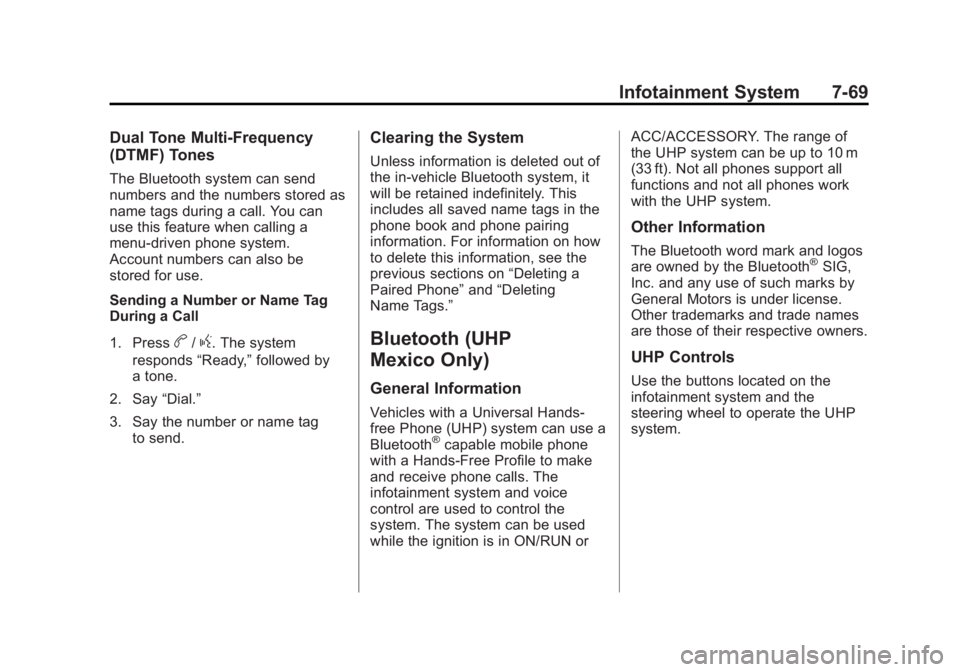
Black plate (69,1)Buick LaCrosse Owner Manual - 2012
Infotainment System 7-69
Dual Tone Multi-Frequency
(DTMF) Tones
The Bluetooth system can send
numbers and the numbers stored as
name tags during a call. You can
use this feature when calling a
menu‐driven phone system.
Account numbers can also be
stored for use.
Sending a Number or Name Tag
During a Call
1. Press
b/g. The system
responds “Ready,”followed by
a tone.
2. Say “Dial.”
3. Say the number or name tag to send.
Clearing the System
Unless information is deleted out of
the in‐vehicle Bluetooth system, it
will be retained indefinitely. This
includes all saved name tags in the
phone book and phone pairing
information. For information on how
to delete this information, see the
previous sections on “Deleting a
Paired Phone” and“Deleting
Name Tags.”
Bluetooth (UHP
Mexico Only)
General Information
Vehicles with a Universal Hands‐
free Phone (UHP) system can use a
Bluetooth
®capable mobile phone
with a Hands-Free Profile to make
and receive phone calls. The
infotainment system and voice
control are used to control the
system. The system can be used
while the ignition is in ON/RUN or ACC/ACCESSORY. The range of
the UHP system can be up to 10 m
(33 ft). Not all phones support all
functions and not all phones work
with the UHP system.
Other Information
The Bluetooth word mark and logos
are owned by the Bluetooth®SIG,
Inc. and any use of such marks by
General Motors is under license.
Other trademarks and trade names
are those of their respective owners.
UHP Controls
Use the buttons located on the
infotainment system and the
steering wheel to operate the UHP
system.
Page 259 of 512
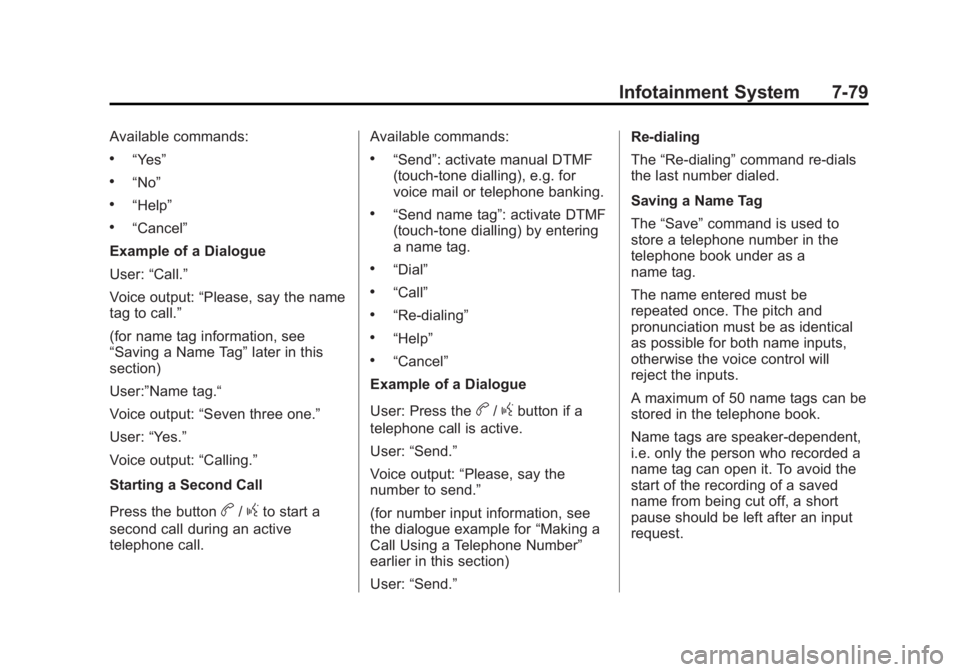
Black plate (79,1)Buick LaCrosse Owner Manual - 2012
Infotainment System 7-79
Available commands:
.“Yes”
.“No”
.“Help”
.“Cancel”
Example of a Dialogue
User: “Call.”
Voice output: “Please, say the name
tag to call.”
(for name tag information, see
“Saving a Name Tag” later in this
section)
User:”Name tag.“
Voice output: “Seven three one.”
User: “Yes.”
Voice output: “Calling.”
Starting a Second Call
Press the button
b/gto start a
second call during an active
telephone call. Available commands:
.“Send”: activate manual DTMF
(touch-tone dialling), e.g. for
voice mail or telephone banking.
.“Send name tag”: activate DTMF
(touch-tone dialling) by entering
a name tag.
.“Dial”
.“Call”
.“Re-dialing”
.“Help”
.“Cancel”
Example of a Dialogue
User: Press the
b/gbutton if a
telephone call is active.
User: “Send.”
Voice output: “Please, say the
number to send.”
(for number input information, see
the dialogue example for “Making a
Call Using a Telephone Number”
earlier in this section)
User: “Send.” Re-dialing
The
“Re-dialing” command re-dials
the last number dialed.
Saving a Name Tag
The “Save” command is used to
store a telephone number in the
telephone book under as a
name tag.
The name entered must be
repeated once. The pitch and
pronunciation must be as identical
as possible for both name inputs,
otherwise the voice control will
reject the inputs.
A maximum of 50 name tags can be
stored in the telephone book.
Name tags are speaker-dependent,
i.e. only the person who recorded a
name tag can open it. To avoid the
start of the recording of a saved
name from being cut off, a short
pause should be left after an input
request.
Page 260 of 512
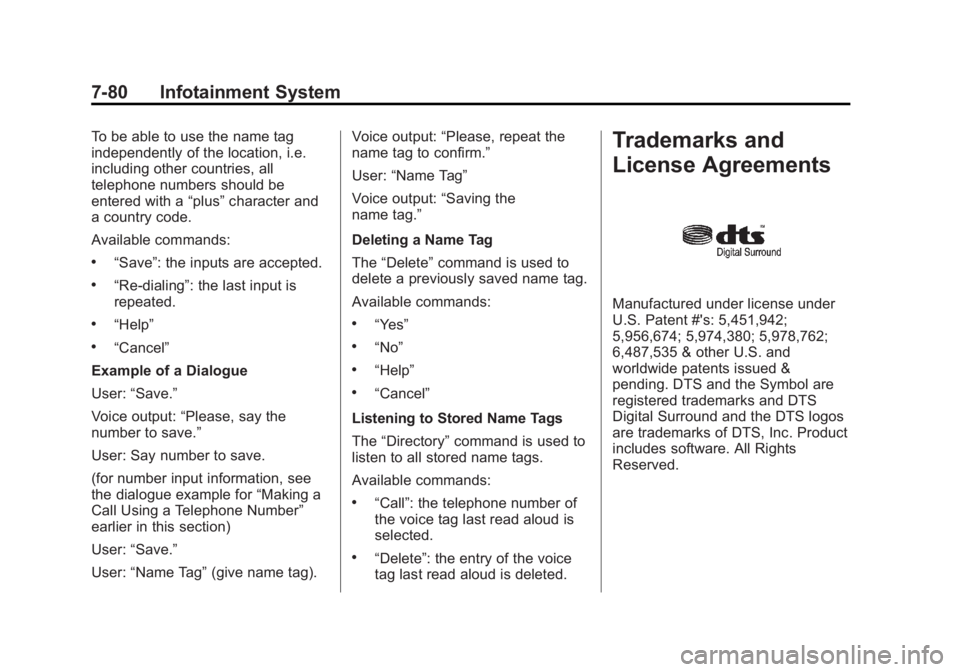
Black plate (80,1)Buick LaCrosse Owner Manual - 2012
7-80 Infotainment System
To be able to use the name tag
independently of the location, i.e.
including other countries, all
telephone numbers should be
entered with a“plus”character and
a country code.
Available commands:
.“Save”: the inputs are accepted.
.“Re-dialing”: the last input is
repeated.
.“Help”
.“Cancel”
Example of a Dialogue
User: “Save.”
Voice output: “Please, say the
number to save.”
User: Say number to save.
(for number input information, see
the dialogue example for “Making a
Call Using a Telephone Number”
earlier in this section)
User: “Save.”
User: “Name Tag” (give name tag). Voice output:
“Please, repeat the
name tag to confirm.”
User: “Name Tag”
Voice output: “Saving the
name tag.”
Deleting a Name Tag
The “Delete” command is used to
delete a previously saved name tag.
Available commands:
.“Yes”
.“No”
.“Help”
.“Cancel”
Listening to Stored Name Tags
The “Directory” command is used to
listen to all stored name tags.
Available commands:
.“Call”: the telephone number of
the voice tag last read aloud is
selected.
.“Delete”: the entry of the voice
tag last read aloud is deleted.
Trademarks and
License Agreements
Manufactured under license under
U.S. Patent #'s: 5,451,942;
5,956,674; 5,974,380; 5,978,762;
6,487,535 & other U.S. and
worldwide patents issued &
pending. DTS and the Symbol are
registered trademarks and DTS
Digital Surround and the DTS logos
are trademarks of DTS, Inc. Product
includes software. All Rights
Reserved.
Page 277 of 512
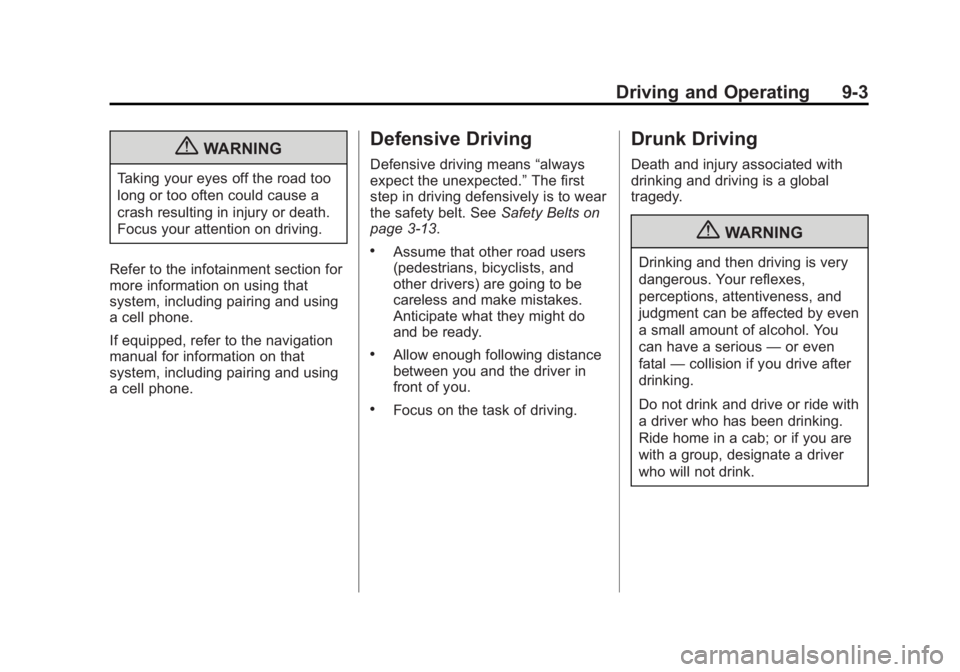
Black plate (3,1)Buick LaCrosse Owner Manual - 2012
Driving and Operating 9-3
{WARNING
Taking your eyes off the road too
long or too often could cause a
crash resulting in injury or death.
Focus your attention on driving.
Refer to the infotainment section for
more information on using that
system, including pairing and using
a cell phone.
If equipped, refer to the navigation
manual for information on that
system, including pairing and using
a cell phone.
Defensive Driving
Defensive driving means “always
expect the unexpected.” The first
step in driving defensively is to wear
the safety belt. See Safety Belts on
page 3‑13.
.Assume that other road users
(pedestrians, bicyclists, and
other drivers) are going to be
careless and make mistakes.
Anticipate what they might do
and be ready.
.Allow enough following distance
between you and the driver in
front of you.
.Focus on the task of driving.
Drunk Driving
Death and injury associated with
drinking and driving is a global
tragedy.
{WARNING
Drinking and then driving is very
dangerous. Your reflexes,
perceptions, attentiveness, and
judgment can be affected by even
a small amount of alcohol. You
can have a serious —or even
fatal —collision if you drive after
drinking.
Do not drink and drive or ride with
a driver who has been drinking.
Ride home in a cab; or if you are
with a group, designate a driver
who will not drink.
Page 287 of 512

Black plate (13,1)Buick LaCrosse Owner Manual - 2012
Driving and Operating 9-13
The Tire and Loading
Information label also shows the
tire size of the original
equipment tires (C) and the
recommended cold tire inflation
pressures (D). For more
information on tires and inflation
seeTires on page 10‑47 and
Tire Pressure on page 10‑54.
There is also important loading
information on the Certification
label. It tells you the Gross
Vehicle Weight Rating (GVWR)
and the Gross Axle Weight
Rating (GAWR) for the front and
rear axle. See “Certification
Label” later in this section. Steps for Determining Correct
Load Limit
1.Locate the statement
“The
combined weight of
occupants and cargo should
never exceed XXX kg or
XXX lbs” on your vehicle's
placard.
2.Determine the combined
weight of the driver and
passengers that will be riding
in your vehicle.
3.Subtract the combined
weight of the driver and
passengers from XXX kg or
XXX lbs.
4.The resulting figure equals
the available amount of cargo
and luggage load capacity.
For example, if the “XXX”
amount equals 1400 lbs and
there will be five 150 lb
passengers in your vehicle,
the amount of available cargo
and luggage load capacity is
650 lbs (1400 −750 (5 x 150)
= 650 lbs).
5.Determine the combined
weight of luggage and cargo
being loaded on the vehicle.
That weight may not safely
exceed the available cargo
and luggage load capacity
calculated in Step 4.
Page 290 of 512

Black plate (16,1)Buick LaCrosse Owner Manual - 2012
9-16 Driving and Operating
And, if there is a heavy load, it
should be spread out. See
“Steps for Determining Correct
Load Limit”earlier in this
section.
{WARNING
Do not load the vehicle any
heavier than the Gross
Vehicle Weight Rating
(GVWR), or either the
maximum front or rear Gross
Axle Weight Rating (GAWR).
This can cause systems to
break and change the way the
vehicle handles. This could
cause loss of control and a
crash. Overloading can also
shorten the life of the vehicle. If you put things inside the
vehicle
—like suitcases, tools,
packages, or anything
else —they will go as fast as the
vehicle goes. If you have to stop
or turn quickly, or if there is a
crash, they will keep going.
{WARNING
Things inside the vehicle can
strike and injure people in a
sudden stop or turn, or in a
crash.
.Put things in the cargo
area of the vehicle. In the
cargo area, put them as
far forward as possible.
Try to spread the weight
evenly.
(Continued)
WARNING (Continued)
.Never stack heavier
things, like suitcases,
inside the vehicle so that
some of them are above
the tops of the seats.
.Do not leave an
unsecured child restraint
in the vehicle.
.Secure loose items in the
vehicle.
.Do not leave a seat folded
down unless needed.
Page 320 of 512

Black plate (46,1)Buick LaCrosse Owner Manual - 2012
9-46 Driving and Operating
When the System Does Not
Seem to Work Properly
The following messages may be
displayed on the DIC:
SERVICE PARK ASSIST:If this
message occurs, take the vehicle to
your dealer to repair the system.
PARK ASSIST OFF: If the URPA
system does not activate due to a
temporary condition, this message
displays on the DIC. This can occur
under the following conditions:
.The driver has disabled the
system.
.The ultrasonic sensors are not
clean. Keep the vehicle's rear
bumper free of mud, dirt, snow,
ice, and slush. For cleaning
instructions, see Exterior Care
on page 10‑102.
.The park assist sensors are
covered by frost or ice. Frost or
ice can form around and behind
the sensors and may not always
be seen; this can occur after
washing the vehicle in cold
weather. The message may not
clear until the frost or ice has
melted.
.An object was hanging out of the
trunk during the last drive cycle.
Once the object is removed,
URPA will return to normal
operation.
.The bumper is damaged. Take
the vehicle to your dealer to
repair the system.
.Other conditions, such as
vibrations from a jackhammer or
the compression of air brakes on
a very large truck, are affecting
system performance.
Side Blind Zone
Alert (SBZA)
The vehicle may have a Side Blind
Zone Alert (SBZA) system. Read
this entire section before using the
system.
{WARNING
SBZA does not detect vehicles
rapidly approaching outside of the
side blind zones, pedestrians,
bicyclists, or animals. Failure to
use proper care when changing
lanes may result in injury, death,
or vehicle damage. Always check
for other vehicles and use the
turn signals when changing lanes.
Page 323 of 512
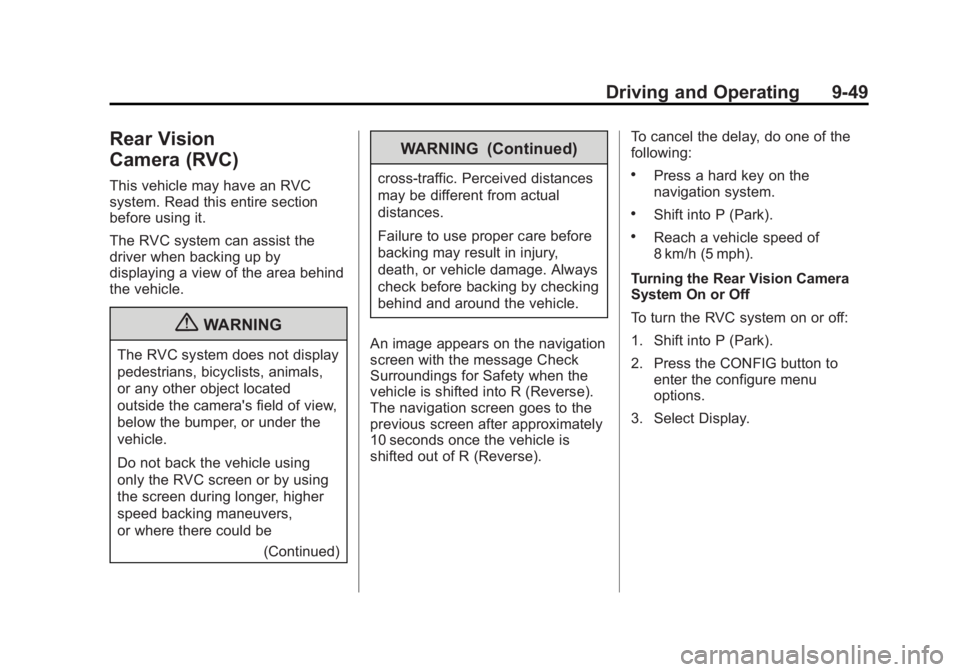
Black plate (49,1)Buick LaCrosse Owner Manual - 2012
Driving and Operating 9-49
Rear Vision
Camera (RVC)
This vehicle may have an RVC
system. Read this entire section
before using it.
The RVC system can assist the
driver when backing up by
displaying a view of the area behind
the vehicle.
{WARNING
The RVC system does not display
pedestrians, bicyclists, animals,
or any other object located
outside the camera's field of view,
below the bumper, or under the
vehicle.
Do not back the vehicle using
only the RVC screen or by using
the screen during longer, higher
speed backing maneuvers,
or where there could be(Continued)
WARNING (Continued)
cross-traffic. Perceived distances
may be different from actual
distances.
Failure to use proper care before
backing may result in injury,
death, or vehicle damage. Always
check before backing by checking
behind and around the vehicle.
An image appears on the navigation
screen with the message Check
Surroundings for Safety when the
vehicle is shifted into R (Reverse).
The navigation screen goes to the
previous screen after approximately
10 seconds once the vehicle is
shifted out of R (Reverse). To cancel the delay, do one of the
following:.Press a hard key on the
navigation system.
.Shift into P (Park).
.Reach a vehicle speed of
8 km/h (5 mph).
Turning the Rear Vision Camera
System On or Off
To turn the RVC system on or off:
1. Shift into P (Park).
2. Press the CONFIG button to enter the configure menu
options.
3. Select Display.